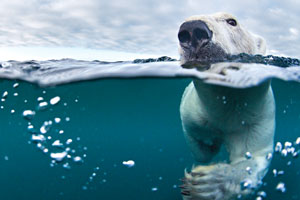This powerful emotion has benefits for the mind, body and spirit.
Growing up in a small farming community in the foothills of Mount Rainier in Washington, Melanie Rudd couldn’t explain the sense of reverence she felt every time she gazed up at the imposing peaks.
“I grew up hiking and camping, and when I was in the outdoors it changed the way I felt. But I didn’t really know what that was or have a good label for it,” Melanie says. She found a name for those powerful emotions when she began studying awe while pursuing her Ph.D. at Stanford University. Today, as assistant professor of marketing at Bauer College of Business at the University of Houston, her areas of research include time perception, emotions, mood and prosocial behavior—all of which are linked to feelings of awe.
“There are several emotions we don’t see a lot of research about and don’t talk much about,” she says. “Awe has been one of those; it’s something that our culture has only [recently] decided is important to talk about.”
Awe in action
Historically, awe has been largely overlooked by science, even though it is something all of us experience (and benefit from) throughout our lives. It wasn’t until 2003, when Dacher Keltner, Ph.D., of the University of California, Berkeley and Jonathan Haidt, Ph.D., then at the University of Virginia, turned their attention to the study of awe that modern psychology began to see it as a viable emotion worth examining.

Dacher and Jonathan’s pivotal 2003 research on awe de fines it as “the feeling of being in the presence of something vast and greater than the self, that exceeds current knowledge structures.”
More simply put, awe is that feeling you get when you witness a stunning sunset, listen to a stirring piece of music or observe a powerful work of art. It can be triggered by a religious or spiritual experience, or caused by a powerful personal experience such as the birth of a child. That results in an intense emotional response that can overlap with such states as wonder, curiosity or even fear.
“Awe occurs when you are presented with an experience that is so much bigger than your understanding of the world,” Lani says. “It’s different from other positive emotions, and it has a suite of effects on our physiology, behavior and cognition. It’s this massive intake of information that doesn’t fit with your current world.”
That requires a process that Dacher and Jonathan referred to as “accommodating,” in which your thought process must expand in order to understand, or accommodate, what you’ve just experienced. Such a process is one more way that awe and its effects differ from other positive emotions, according to Lani.
“Most positive emotions feel activating, they make you want to move,” she says. “Awe slows us down physiologically. It actually reduces our fight-or- flight response and is physically soothing. Awe makes you focus on one thing, in a broad way, and put your attention fully on the experience.”
In that way, it is similar to mindfulness and shares some of the same emotional and physiological benefits. It can hit the pause button on our automatic behavior and thought processes and change our emotional states. It even has been found to help correct negative health behaviors such as smoking a cigarette or eating food that you know isn’t good for you.
“We now have seen that even a brief dose of awe can help put a brake on us” and redirect our actions, according to Lani.
Listen to our podcast with Lani Shiota:
Expanding awe
Tricia Schers spent much of her young adult life traveling; she has gone whale watching in Hawaii, seen the sea turtles nesting in Suriname and trekked through Thailand. But when she took a marketing job for Frontiers North, an adventure tourism company based in Churchill, Manitoba, Canada, she says her level of awe increased exponentially.
“I was three days into the job when they sent me to Churchill to experience one of their tours,” she recalls. “I got to see beluga whales in the wild, nine polar bears—including a mother nursing a cub—and the northern lights. I was blown away.”
Even today, she feels that same sense of humbled reverence every time she encounters the rugged, frozen paradise.
“There’s a reason people use the word ‘majestic’ when they describe seeing polar bears in their natural environment,” Tricia says. “I can sit and watch the landscape and become completely mesmerized. Somehow you feel the interconnection of the ecosystems; the landscape is rugged, yet you can sense the fragility of it.
“It is simply awe-inspiring.”
While the use of the word “awe” may have worn down its true signi ficance (just note the overuse of “awesome!” in daily conversation), the fact is that true awe is a deeply felt emotion with powerful implications.

“Most of our worries and concerns are derived from a hyperfocus on our self,” he points out. “When that focus on our self is reduced, so, too, are many of our concerns. And when you feel you are less of a center for concern, you feel more connected to people.”
Experiencing a sense of awe, he says, immediately removes the focus from self and resets our thinking to see our surroundings differently.
“Evidence shows that awe might be an important part of the mental health diet,” he says. “It’s associated with well-being and with pro-social behavior. So if you care about increasing your overall well-being, awe is one way to do that. We still don’t know exactly how or why, but it’s safe to say that awe forms a pathway to well-being.”
He says the last decade has seen interest in awe increase as more research has been released to show its causes as well as its effects. Each study adds to its credibility while at the same time raising new questions that can be explored, such as whether certain traits make us more open to experience awe and how long its impact lasts. David is currently working with Dacher to help build “a more robust scale” for measuring awe’s bene fits.
“Sometimes the value of these experiences is hard to pin down,” he says. “But if you ask someone about their most awe-inspiring moment, they will see it as something that was profoundly meaningful.”
Slowing the clock
As awe gains more traction as a research topic, more aspects and benefits are being examined. Among the more interesting outcomes, Melanie has found in her ongoing research at the University of Houston that awe can be useful in changing our perception of time.
“This could be particularly useful because today people feel increasingly pressed for time,” she says. “When you look at what time pressure and time famine are doing to us, it’s not healthy.”
When we’re pressed for time, we tend to eat on the run (and make poorer food choices), have lower levels of life satisfaction and will postpone self-care, such as doctor and dental appointments. We’re also more likely to over-purchase goods, even though we may not need them. While most of us feeling the crunch of the clock wish for just a few more hours in the day, perhaps what we really need is just a little more awe in our lives.
“Rather than try to change the amount of time people have, we look at how to change their perception of that time,” Melanie says. Her studies reinforce Lani’s work showing that awe requires you to be in the moment. “When you are in the experience of awe, it really sucks you in,” she explains. “You can’t wander into the past or the future. You are in the present, and you’re taking in all the sights and sounds and smells of that moment.” As your brain works to process and encode these changes in the environment and your emotions, “time feels more expansive, more full and rich.”
Because you crammed so much information into this time, the perception is that time slows down. And along with that sense of having extra time comes less irritability and a greater tendency to give others the gift of your time.
“[In our studies] when people looked at the diary of what they had experienced, it really did look like they had more time,” Melanie says. “They were more inclined to volunteer, which had additional benefits by giving them that ‘helper’s high.’ No matter how much money you make, the common thread between us is that everyone is pressed for time. Maybe if we find ways to alleviate the time stress, we’ll start to make better decisions for our well-being.”
Incorporating awe
If awe is one pathway to well-being, it is a pathway with many entry points. Researchers often use pictures or virtual reality in the laboratory setting to create a sense of awe in their subjects. For those of us who aren’t being studied, it’s much easier.
It doesn’t require a trip to the Grand Canyon or to see the northern lights; you can find awe in your own home, your backyard or with friends.
“You have to know what has a better chance of eliciting an awe response for you, personally,” Melanie advises. “It can be nature or music or art or even other people’s accomplishments. Think about what inspires you.”
She suggests seeking out new experiences. Whether that’s visiting a park you haven’t been to before, taking an exotic trip or just getting out and meeting new people, a new experience “increases the odds that you’ll find something awe-inspiring,” Melanie says. And, when you do find it, collect it. Save pictures or videos in a computer folder to look at when you’re feeling like you need a boost; you might be surprised how much good it does you.
“By the time we hit adulthood, we’re on autopilot; we kind of have to be,” Lani adds. “We store knowledge and do the same thing day after day, and that’s good, because that’s what expertise is. But it doesn’t necessarily feel great.
“Practicing awe breaks us out of autopilot. And it feels nice to break out and be aware of what’s around us in the world.”
Read more: 5 Awe-Inspiring Destinations
Paula Felps is the Science Editor for Live Happy magazine.















